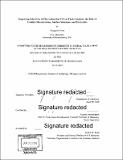| dc.contributor.advisor | Yogesh Surendranath. | en_US |
| dc.contributor.author | Yoon, Youngmin, Ph. D. Massachusetts Institute of Technology | en_US |
| dc.contributor.other | Massachusetts Institute of Technology. Department of Chemistry. | en_US |
| dc.date.accessioned | 2018-09-28T21:00:08Z | |
| dc.date.available | 2018-09-28T21:00:08Z | |
| dc.date.copyright | 2018 | en_US |
| dc.date.issued | 2018 | en_US |
| dc.identifier.uri | http://hdl.handle.net/1721.1/118282 | |
| dc.description | Thesis: Ph. D. in Inorganic Chemistry, Massachusetts Institute of Technology, Department of Chemistry, 2018. | en_US |
| dc.description | Cataloged from PDF version of thesis. | en_US |
| dc.description | Includes bibliographical references. | en_US |
| dc.description.abstract | Mitigating atmospheric CO₂ levels is an important challenge in curbing anthropogenic climate change. To this end, the storage of intermittently generated renewable energy in the chemical bonds of electro-reduced CO₂ is considered an attractive carbon-neutral route to storing CO₂ . However, the selectivity of this reaction, particularly in aqueous electrolytes, remains open to improvement due to both the generation of large quantities of H2 from solvent reduction and the multitude of CO₂ reduction products. This thesis will discuss strategies to improve product selectivity. The first section of this thesis focuses on methods to measure a basic property of electrocatalysts that enables studies on the origin of catalyst activity and that allow for systematic comparisons of catalyst activity: the electrochemical surface area. Using double layer capacitance measurements in aprotic electrolytes and atomic force microscopy to independently determine surface areas, it is possible to obtain a general value of specific capacitance (~11 [mu]F/real cm²) across multiple materials relevant for electrochemical catalysis by minimizing strong ion interactions with the electrode surface. The knowledge of electrode surface areas and the kinetics of CO₂ vs H⁺ activation during CO₂ electroreduction enables the discovery that electrode mesostructure can have significant impacts on CO₂ reduction selectivity. As the electrode structure becomes rougher, diffusion gradients of the HCO₃⁻ proton donor formed at the double layer suppresses H₂ evolution activity. On both Au and Ag electrodes, this leads to a suppression of H2 evolution, while CO₂ reduction current density is enhanced on Ag electrodes on a surface area normalized basis. The last part of this thesis focuses on exploring the kinetics of CO intermediates that gate hydrocarbon selectivity on Cu electrodes. The data indicate a Langmuir-Hinshelwood type mechanism in play for both the production of CH₄ and C₂H₄, whereby surface adsorbed COads react with other surface adsorbed species in a rate limiting fashion. Using this insight, pulsed electrodeposition in an aqueous citrate electrolyte is used to make nanocrystalline Cu electrocatalysts with a high density of grain boundary sites, which have been suggested to have strong CO affinity, and can thus suppress CH₄ and H₂ formation. | en_US |
| dc.description.statementofresponsibility | by Youngmin Yoon. | en_US |
| dc.format.extent | 170 pages | en_US |
| dc.language.iso | eng | en_US |
| dc.publisher | Massachusetts Institute of Technology | en_US |
| dc.rights | MIT theses are protected by copyright. They may be viewed, downloaded, or printed from this source but further reproduction or distribution in any format is prohibited without written permission. | en_US |
| dc.rights.uri | http://dspace.mit.edu/handle/1721.1/7582 | en_US |
| dc.subject | Chemistry. | en_US |
| dc.title | Improving selectivity in electrochemical CO₂-to-fuels catalysis : the role of catalyst mesostructure, surface structure, and electrolyte | en_US |
| dc.type | Thesis | en_US |
| dc.description.degree | Ph. D. in Inorganic Chemistry | en_US |
| dc.contributor.department | Massachusetts Institute of Technology. Department of Chemistry | |
| dc.identifier.oclc | 1054248265 | en_US |
